If you follow news about nature, you may have come across warnings that the monarch butterfly (Danaus plexippus) has been in rather dire straits for many years now.
These lovely orange and black butterflies live from 6 to 8 weeks when they are adults engaged in reproduction. Those who live in the Eastern USA participate in a multi-generational migration process between Canada and central Mexico. The last generation to emerge in late summer is able to delay its sexual maturity to undertake the last leg of the migratory journey (called reproductive diapause) and may live up to 8 months. Individual butterflies may travel as far as 1200-3000 miles to get to their warmer over-wintering grounds.
 Since the 1980s, the Eastern US monarch population has declined by about 80%, mainly because the only food source for their caterpillars has been disappearing. Milkweeds used to grow abundantly in agricultural areas and along roadsides and ditches, but people have been eradicating the plants from fields and using herbicides and mowing to remove them along roads.
Since the 1980s, the Eastern US monarch population has declined by about 80%, mainly because the only food source for their caterpillars has been disappearing. Milkweeds used to grow abundantly in agricultural areas and along roadsides and ditches, but people have been eradicating the plants from fields and using herbicides and mowing to remove them along roads.
Climate change has also affected the butterflies’ breeding and migratory patterns so that reproduction has been reduced.
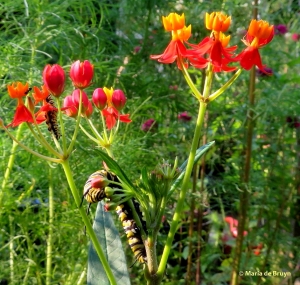 One way to help out the monarchs is to plant native (not exotic!) milkweeds in your own yard and any other natural spaces to which you have access. I’ve been doing it around my home and as a volunteer for the Mason Farm Biological Reserve. This year, I was lucky enough to be a beneficiary of a milkweed give-away organized by some local high-school students, so I had two types of the plants in my yard.
One way to help out the monarchs is to plant native (not exotic!) milkweeds in your own yard and any other natural spaces to which you have access. I’ve been doing it around my home and as a volunteer for the Mason Farm Biological Reserve. This year, I was lucky enough to be a beneficiary of a milkweed give-away organized by some local high-school students, so I had two types of the plants in my yard.
The ones that I had originally planted were common milkweed (Asclepias syriaca). These plants have large globular clusters of flowers that range in color from pinkish to purple. They do not have blooms their first year but that doesn’t stop the caterpillars from eating their leaves.
Butterfly weed (also known as butterfly milkweed; Asclepias tuberosa) is a bit more delicate and “exuberant” in appearance, with small clusters of orange, reddish and yellow flowers. These were the plants that I was gifted by the students and I was happy to see them grow quickly to exhibit their beautiful blooms.
 According to Wikipedia, the butterfly milkweed is not a preferred plant for the monarch but this year the butterflies seemed much more attracted to it than to the common milkweed. After a few visits from some butterflies, I began seeing caterpillars and at one point counted 17 crawling up and down the various plants.
According to Wikipedia, the butterfly milkweed is not a preferred plant for the monarch but this year the butterflies seemed much more attracted to it than to the common milkweed. After a few visits from some butterflies, I began seeing caterpillars and at one point counted 17 crawling up and down the various plants.
They were especially prevalent on the butterfly weed in my front yard and were munching the plants to bare stems very quickly.
To make sure they had enough food, I transferred some of them to the common milkweeds in my back yard – these were larger plants with much broader leaves and I thought this would ensure their healthy development. Frass (poop) was being left on the remaining leaves and the ground surrounding the plants.
 It was rewarding to see three caterpillars make it to the chrysalis stage; the other caterpillars crawled away before I could see where they went, and I didn’t find them suspended from any plants. The first one had attached itself to a bare sapling and, unfortunately, the next day it had disappeared, leaving only the silken thread by which it had been suspended.
It was rewarding to see three caterpillars make it to the chrysalis stage; the other caterpillars crawled away before I could see where they went, and I didn’t find them suspended from any plants. The first one had attached itself to a bare sapling and, unfortunately, the next day it had disappeared, leaving only the silken thread by which it had been suspended.
The caterpillars store milkweed glycosides in their bodies, making them toxic to many other animals. They still have many predators, however, including wasps, spiders, other insects, lizards, toads and mice. I resolved to save at least one chrysalid if I could.
 I got to see the second chrysalis being formed (see the video, which is a little shaky at times). When the caterpillar is ready to undergo the pupation stage, it attaches itself to a plant stem by making a silk pad as an anchor (called a cremaster). Then it inserts the hooks at the end of its abdomen into the pad and hangs down. When the caterpillar forms a J shape, this signals the change to a chrysalis will soon be underway.
I got to see the second chrysalis being formed (see the video, which is a little shaky at times). When the caterpillar is ready to undergo the pupation stage, it attaches itself to a plant stem by making a silk pad as an anchor (called a cremaster). Then it inserts the hooks at the end of its abdomen into the pad and hangs down. When the caterpillar forms a J shape, this signals the change to a chrysalis will soon be underway.
Starting from the head, the outer skin is shed, rolling up as the new covering develops. The shed skin may remain at the silk pad or fall off.
Slowly the stripes of the caterpillar disappear, and the chrysalis takes on a shiny even green hue, with some golden accent spots.
I kept that chrysalis, as well as a third one I saw the next morning, in my house and waited for them to darken. This signals the butterfly is almost through developing inside.
One morning I found the newly emerged monarch from the second chrysalis drying its wings. I took it outside so that it could fly free and then begin its trip to Mexico. (I also took the third one outside when it darkened but the twig holding it disappeared.)
 You, too, could contribute to their propagation by planting some milkweed if you have an area for this. Autumn is the best time to plant seeds, but you can try it in the spring as well. Common milkweed typically doesn’t flower during its first year, but butterfly weed will give you flowers in its first season; the latter plants may be slow to emerge at first.
You, too, could contribute to their propagation by planting some milkweed if you have an area for this. Autumn is the best time to plant seeds, but you can try it in the spring as well. Common milkweed typically doesn’t flower during its first year, but butterfly weed will give you flowers in its first season; the latter plants may be slow to emerge at first.
Both of these milkweed varieties are perennials so be sure to remember where you planted them. Common milkweed may spread out with time, while butterfly weed remains where you put it.
Other flowering plants will attract the adult monarchs, too, for nectaring, such as asters and lantana.
And then sit back next year and wait for the monarchs to arrive, happy in the knowledge that you have contributed to maintaining a favorable environment for their survival.
More ideas on how you can participate in the drive to save this iconic butterfly are detailed on a U.S. Fish & Wildlife Service website: https://www.fws.gov/savethemonarch/


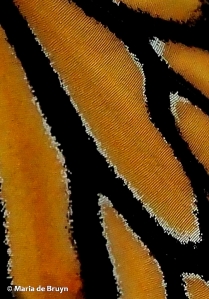








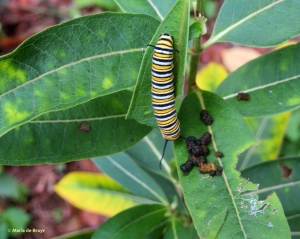

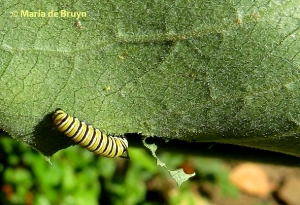








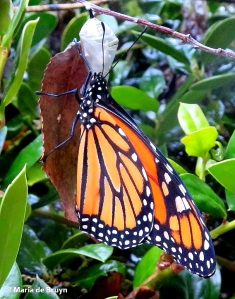



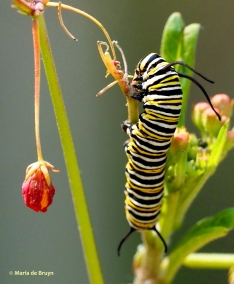



What a beautiful and informative post!
LikeLiked by 1 person
Thanks, Mary. If it inspires anyone to plant some milkweed, that would be very cool!
LikeLike
Gorgeous photos! This week when I walked the Mason Farm trail that runs from the wetland to the hazardous waste shed, I noticed a new crop of milkweeds starting to grow up a little way down from the patch that has been cordoned off. I was glad to see them!
LikeLiked by 1 person
Thank you, Lucretia. I noticed that as well when I walked that path recently! I’ve been seeing some in woods bordering Jordan Lake and fortunately saw a monarch there as well so I’m hopeful!
LikeLike
Thank you for this info on Asclepias tuberosa. I’ve avoided it as a non-Eastern native for years, now realizing that was a big mistake. Your photos are stunning!
LikeLike
Thanks, Michele! It’s great that you learned something new – I did as well when I was researching information for the blog. I’ve been very pleased with the butterfly weed and hope you will be, too!
LikeLike